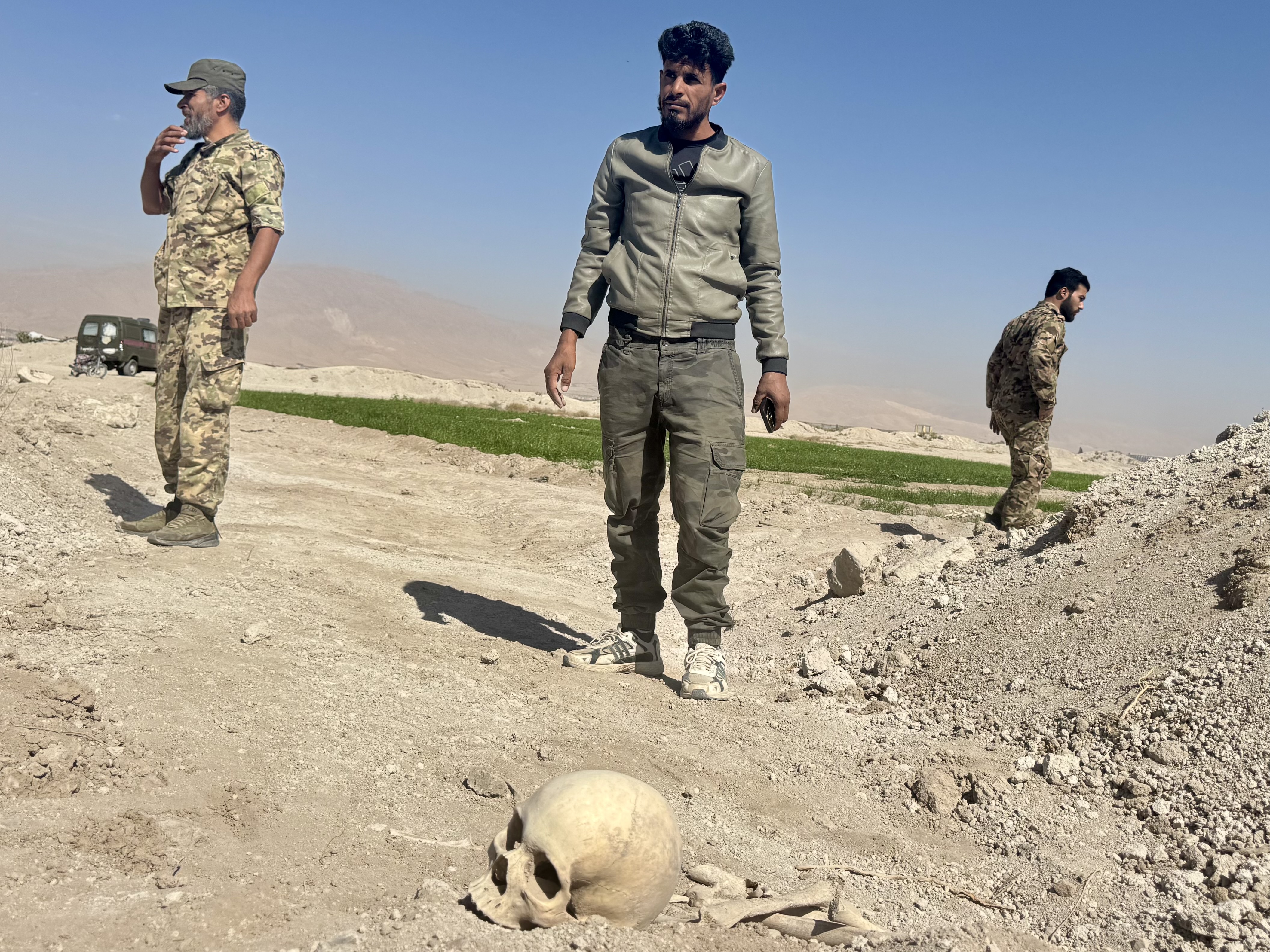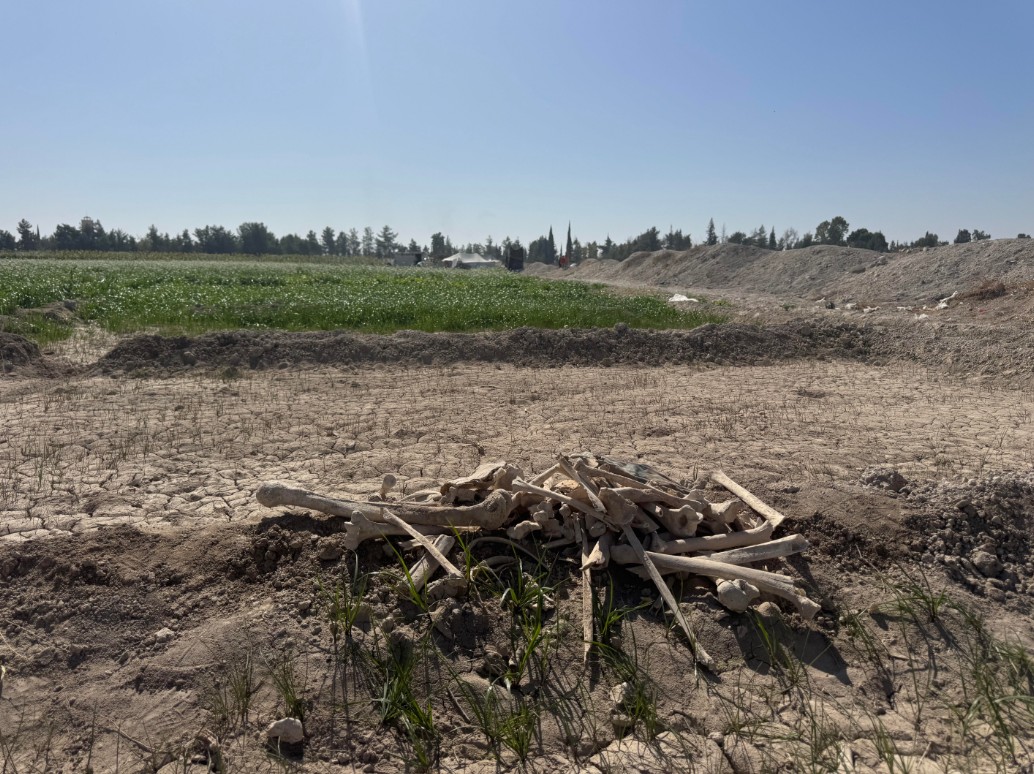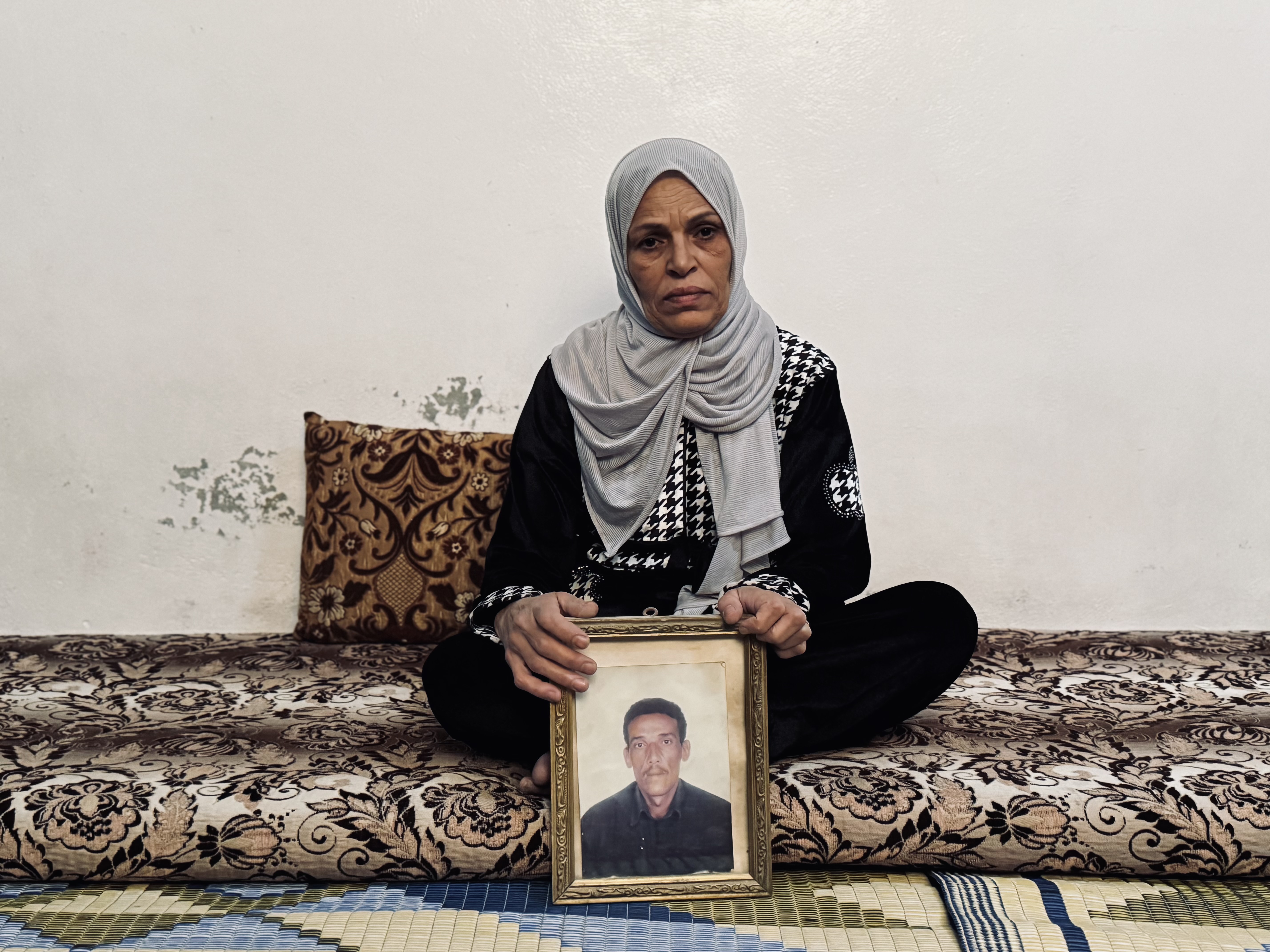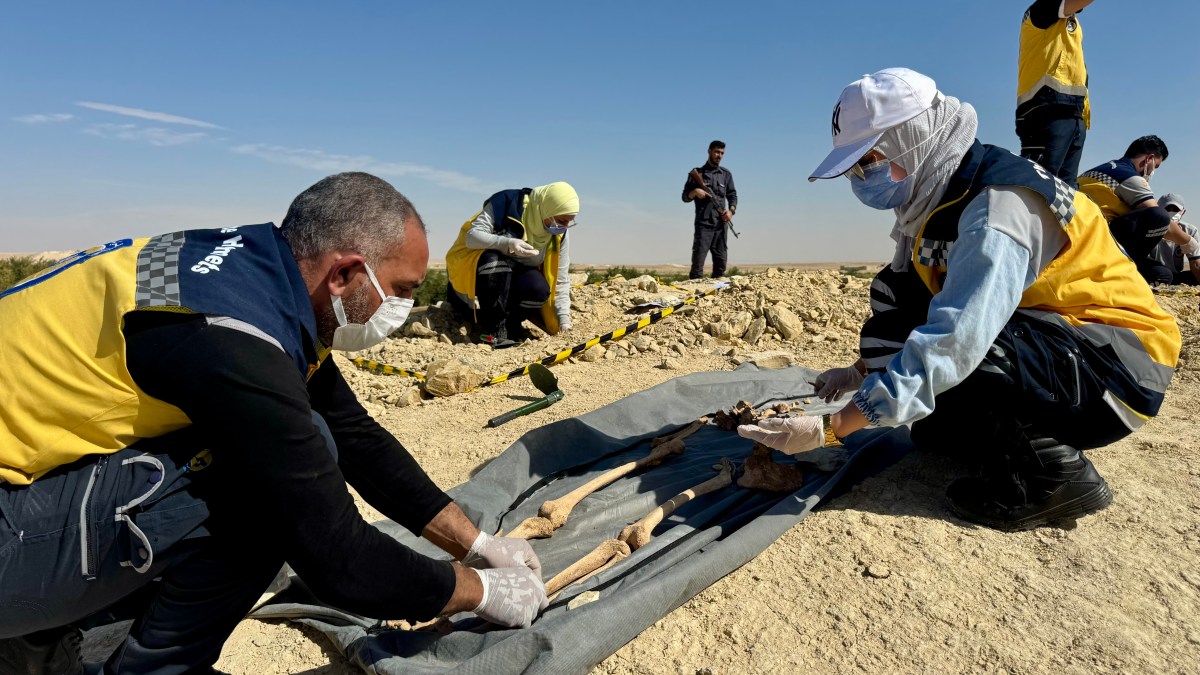A thin man with hooded eyes and a face sculptured by war and the desert stared down at the bones in the dust.
“I tried to warn them,” he said, looking at the human debris at his feet. “I told them not to come this way. I said the checkpoint here could not be trusted; that the soldiers would lie and offer safe passage, then kill those who went down this path.”
It was seven years ago that Suliman Awayed last saw the group of frightened civilians attempting to escape down this path from eastern Ghouta, a suburb of Damascus being fought over by regime and rebel forces in Syria’s civil war. A regime-controlled checkpoint sat at one end of the track, and the civilians, fleeing the violence, believed that they had been offered safe passage by the soldiers.
“I didn’t see them die,” the 41-year-old farmer added. “But I heard the shooting. The regime soldiers would often do that at this checkpoint: offer desperate people a corridor out, take their money, then kill them.”

Suliman Awayed in eastern Ghouta
ANTHONY LOYD FOR THE TIMES
After returning to the ruins of his own home last week, Awayed spoke as he guided a forensic team from Syria’s Truth Guardians, formerly a branch of the White Helmets rescue service, as they gathered clusters of human bones from fields on each side of the pathway.
“I tried to warn them,” he said again, gazing at the bones, as if the mantra of his words could turn back time.
How search for dead became a political issue
Nearly a year after the overthrow of President Assad, Syria’s new government has been overwhelmed by the amount of human remains found buried in mass graves and the scores of bodies found lying in fields, ditches and streets.
More than 160,000 Syrian prisoners disappeared into Assad’s cells and interrogation centres, and the total number of missing since his family’s rule began in 1970 is believed to exceed 300,000.
Locating and identifying the missing, and gathering evidence from the scenes of killing and burial that could bring the perpetrators of Syria’s state-run slaughter to justice, are key to the country’s chances of stability.
To that end, this year Ahmed al-Sharaa, who ousted Assad, established two committees: the National Committee for Missing Persons (NCMP) and the National Committee for Transitional Justice (NCTJ) to help locate the missing and punish the guilty.
• Only 25 people can solve Syria’s darkest puzzle. They’re dentists
But neither committee is fully operational yet and tensions resulting from the delay and the desperation of millions of Syrians to find the graves of their loved ones has made the search for the dead a febrile political issue.
“There is huge pressure to start the identification process with so many graves and exposed human remains being found,” said Farouq Habib, the executive director of Truth Guardians, whose forensic teams co-ordinate with the two committees.
“The first demand of families of the missing is for answers,” he added. “Mothers want to know the whereabouts of missing sons. Their priority is not to know who killed their sons, but to know where their bodies are. They want to find the body and give their loved one the dignity of a tomb. Then, after that, most want justice. They want the perpetrators brought to account.”
Reports of more than 70 mass graves
Human bones collected by farmers in eastern Ghouta
ANTHONY LOYD FOR THE TIMES
As he drove to meet one of his forensic teams among the scattered bones in eastern Ghouta, Ammar al-Selmo, forensic programme manager for the Truth Guardians, reflected on the bodies they had already collected since Assad’s downfall.
First there were the 23 bags of human bones, likely from dead Iranians, he had found stashed at the Happy Land amusement park in Damascus soon after Assad’s ousting. Then there were the 1,100 bodies of regime soldiers recovered from battlefields: troops killed during the weeks of fighting in November and early December that preceded Assad’s flight.
There was the occasion when Selmo and his teams had gone to a village outside Hama where the skeletons of three dead men were found in a ruined house. While there, the dead men’s family, displaced five years earlier, had arrived and an elderly man recognised one of the skeletons as that of his son by the clothes on the bones.
“My son, my son,” Selmo recalled the old man crying. When the Truth Guardians explained that they would have to take the body away pending forensic examination, the old man broke down.
“He said he would kill himself if I took his son’s body away, so in the end I left the bones there for him to bury,” Selmo said.
As well as collecting hundreds of bodies over the past ten months that have been found lying in the open, the Truth Guardians have received detailed reports of more than 70 mass graves. Some, such as the sites in Qutayfah and Dhumair, are believed to contain the bodies of tens of thousands of prisoners executed by the regime.
Most of these bodies have yet to be identified. Without any functioning DNA lab in Syria, the mass graves are assessed and left unopened pending future exhumation; the above-surface skeletons collected and boxed in storage facilities; and fresh bodies examined, registered and buried in cross-referenced graves: all part of an accumulation of evidence that one day could bring leading figures of the ousted regime to justice.
‘Without a body, my children can’t accept their father’s dead’
Yet despite being the main Syrian organisation for forensic investigation, the Truth Guardians are pitifully under-resourced. They have only 65 personnel in total, including three teams each with 14 staff operating nationwide, in a country of 71,500 square miles.
Moreover, different priorities exist between the Truth Guardians — whose staff operate at first hand among the dead and bereaved, and thus feel a natural desire to expedite the identification of the missing — and the two committees established by Sharaa, who have a slower, more investigative approach.
“We can’t rush to open the mass graves,” said Aweiss al-Doboush, a judicial adviser on the board of the NCMP. “It’s not just about finding and identifying the missing: it is about finding the truth about what happened.”
“The key aspect is identifying command responsibility,” he added. “Who really ran the killing machine? How did the orders move from the top down? We should manage expectations about how long that work may take: possibly decades.”
• A tale of two Syrias: some families reunite, others go into hiding
Indeed, even if they wanted to speed up the exhumation and collection of evidence from massacre sites and mass graves, the NCMP and NCTJ would face acute challenges.
There is no single national database of the missing in Syria. Forensic pathology departments were undermined for decades by a regime more intent on killing its opponents and erasing any trace of their existence, than on identifying their bodies. Funding for the committees is scarce. Even the NCTJ’s concept of justice is partial: the committee has been tasked to investigate crimes committed only by the regime, rather than by all parties involved in the 2011-24 civil war.
The tensions caused by these shortfalls and the different approaches to dealing with Syria’s missing run not just through government and civil society, but among families too.
Aziza Ibrahim, 57, last saw her husband, Nasser, when he went to work in southeast Damascus on February 26, 2013. He never came home. She later learnt that her husband had been arrested after a business dispute over bottled cooking gas with an informant, who was paid 25,000 Syrian pounds — the equivalent of $2.50 — each time he told Assad’s security services that someone was “a terrorist”.
• Syrian president Sharaa asks Putin to hand over Assad
“The way my husband, a father who cared for nothing more than his family, was so devalued by the regime that he was sold by an informant into prison for a pittance breaks my heart as much as the injustice,” she said.

Aziza Ibrahim with a picture of her husband, Nasser
ANTHONY LOYD FOR THE TIMES
A year after Nasser Ibrahim’s disappearance the authorities issued Aziza with his death certificate. It showed that her husband had died in captivity, two months after being arrested.
“He wasn’t a tough guy and didn’t last longer than a few weeks under interrogation,” she said last week.
His body was never returned.
“Sometimes, despite it all, I think maybe Nasser is still alive somewhere,” Aziza Ibrahim said. “We have had huge family fights about it. My children say that without a body we shouldn’t accept that their father is dead. I don’t know what to do next. A family court registered Nasser as dead in 2019 but without a body it’s hard for any of us to accept.”
‘These skeletons have become part of Syria’s story’
Stopping his vehicle in eastern Ghouta, Selmo walked towards Awayed and the scattered skeletons not knowing if any family members of the missing in the area, desperate for clues about their loved ones’ fate, would be present at the site.
Once, at a massacre location in nearby Otaybah, Selmo’s teams had encountered two different families squabbling over the same skeleton, each convinced by an article of clothing that it was that of their missing son.
“Both were certain,” Selmo said, “both believing that the bones were theirs. We had no choice but to box the bones and take them away, until the day that a DNA test can solve the issue.”
Yet in eastern Ghouta now, as Truth Guardians with mine detectors swept the roadside for unexploded ordnance and a forensic team appeared to gather and box the bones in their wake, not a single relative of the missing appeared: the disassembled dead remained anonymous — though no longer alone.
“These skeletons have become part of us, part of Syria’s story,” Selmo said as Awayed began pointing out the bones’ locations. “They are like family. It feels like a personal matter. But at the same time, they are also key evidence that might one day lead us to those who killed them.”

